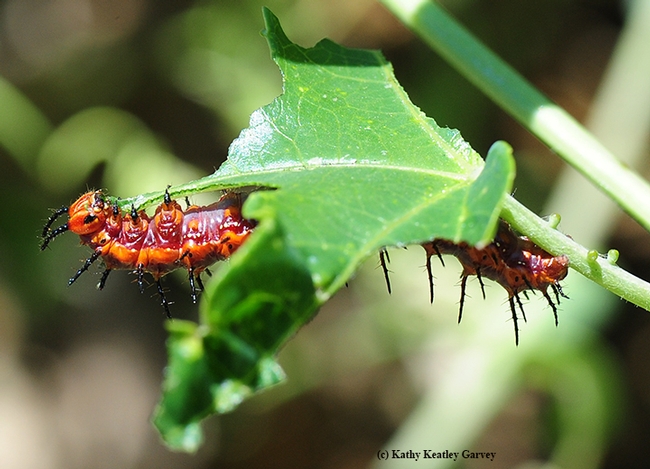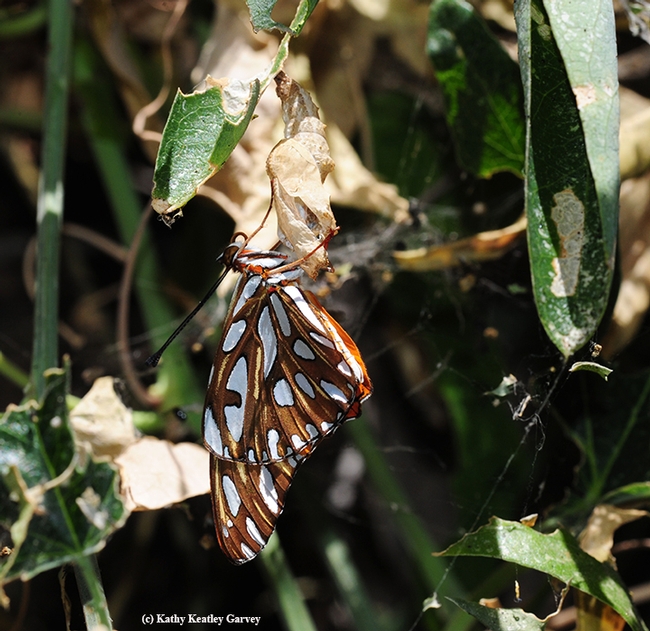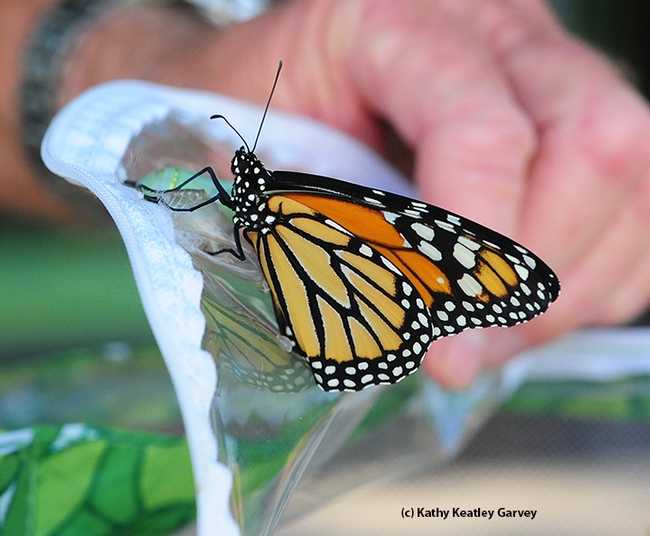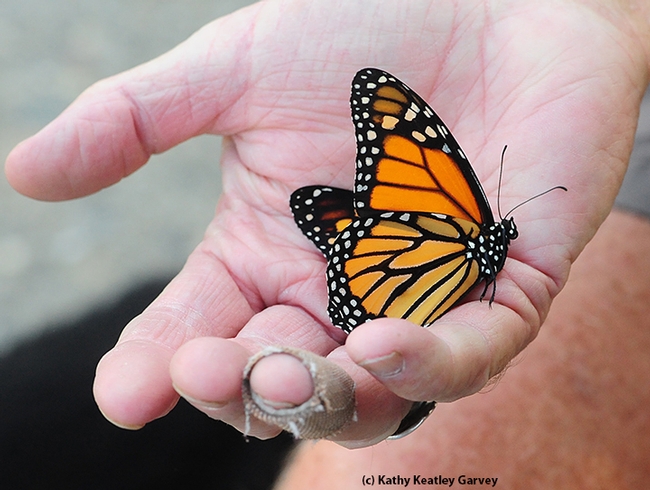- Author: Kathy Keatley Garvey
Let's celebrate the Gulf Fritillary (Agraulis vanillae).
If you have a passionflower vine (Passiflora) in your yard, you've probably seen these spectacular orangish-reddish butterflies with silver-spangled underwings fluttering around--the males patrolling for females, the mating, the females laying eggs, the caterpillars hatching from the eggs, and the caterpillars munching and crunching until their last instar. Then you'll see them forming chrysalids, and butterflies eclosing.
The unseen world of Gulf Frits. The miraculous unseen world of Gulf Frits. Because it is.
That came to mind the other day when two passersby saw a dozen or so Gulf Frits heading into our yard.
"Look at all the butterflies!" one exclaimed. "I wonder what's attracting them."
"I don't know," the other said. "They must have a butterfly bush, maybe?"
"Oh, that's probably it. A butterfly bush."
Well, what's attracting them is the Passiflora, the host plant of the Gulf Frits. It's a congregation without a church. It's a gathering without a sermon. It's Nature at its finest. The Gulf Frits, aka "passion butterflies," lay their eggs only on the passionflower vine--mostly on the tendrils or leaves. The caterpillars will eat only Passiflora. The adults? They'll nectar on such plants as the butterfly bush, Mexican sunflower and lantana but will stay close to the Passiflora for mating and egg-laying.
If you're lucky, you'll see the entire life cycle--from egg to caterpillar to chrysalis to adult.
If you're really lucky, you'll see the tiny yellow eggs, which are about the size of the period at the end of this sentence. The yellow eggs turn from orange to rust, the color of the caterpillar inside.
The butterfly, found in many parts of the world, is a relatively newcomer to California. It was documented in Southern California, in the San Diego area, in the 1870s, according to butterfly guru Art Shapiro, distinguished professor of evolution and ecology at UC Davis. “It spread through Southern California in urban settings and was first recorded in the Bay Area about 1908. It became a persistent breeding resident in the East and South Bay in the 1950s and has been there since.”
Shapiro says it “apparently bred in the Sacramento area and possibly in Davis in the 1960s, becoming extinct in the early 1970s, then recolonizing again throughout the area since 2000.”
Today I explored the unseen and intricate world of Gulf Frits in our Vacaville (Solano County) backyard, managing to capture a few images. Then the unexpected happened. For the first time in the five years we've been rearing Gulf Frits, one landed on me! Apparently mistaking me for a plant, she touched down on my green t-shirt (which probably carried the scent of the passionflower vine). She was all set to lay an egg until....two males approached. Startled and a bit rattled--hey, I'm laying an egg here, leave me alone!--off she flew.
This time she vanished inside the depths of the passionflower vine.
With any luck, she'll do just fine in this congregation without a church, in this gathering without a sermon. She'll provide another generation that resembles the striking colors of those stained glass windows in a religious sanctuary.





- Author: Kathy Keatley Garvey

For a couple of months now, we've been watching the monarch caterpillars slowly disappearing from our milkweed plants. We'd see fifth instar 'cats one day, and the next day, they'd be gone. Then we'd see the Western scrub jays flying through the yard and landing near the plants. Culprits!
Okay, we thought, we'll get some bird netting to circle the milkweeds. The net kept the birds out but not the 'cats. They crawled out of the bird netting right into the beaks of the birds.
Okay, we thought, how about some tulle or wedding veil-type fabric or those zippered hampers to pop over the plants? Those worked better. Not as many escapees.
But what really worked was bringing the caterpillars into the house and placing them into the butterfly habitat containers (from the Bohart Museum of Entomology, University of California, Davis). Daily we'd feed the 'cats bouquets of fresh milkweed tucked into a narrow-throated, flat/wide-bottomed bottle. I think that in its other life, it was a tequila bottle. It went from borrowed tequila bottle to butterfly bottle.
The first one to eclose was a male. The second one, a female. Releasing them was pure joy.
Then today, two more eclosures. First, a male. Then a female. As soon as their wings dried, we released them. The male fluttered rather clumsily (okay, it was his first flight). The female preferred to soak up some sunshine as she clung tightly to a butterfly bush.
If we hadn't brought the caterpillars into the house, would they have reached the adult stage? Probably not. Scientists say that only 10 percent make it from egg to adult in the wild.
Watching the transformation from egg, to caterpillar, to a gold-studded jade-green jewel (chrysalis) to an adult is just plain exhilaration and jubilation. Such bliss. No wonder monarch conservations are addicted. It's like watching the miracle of life unfold.
Hollywood actors and actresses who deliver their acceptance speeches at the Academy Award ceremonies have nothing on us.
We Monarch Moms and Dads can deliver A-'Cat-emy Award presentations, too. (Of course, we have butterflies in our stomachs because we're not used to being on stage.)
"First we'd like to thank the nursery for providing these narrow-leafed milkweeds. Then we'd like to thank the Good Earth for providing such a healthy environment to allow the growth of these plants. Then we'd like to thank Mr. and Mrs. Monarch for..um...getting together, and Mrs. Monarch for kindly laying her eggs on these plants. Mrs. Monarch, that was really very nice of you! Thank you so much!"
"And finally, we are here to tell you that change is good. It can transform you. You say you don't believe that a leaf-munching caterpillar can become a glorious butterfly? Let us tell you what the word, metamorphosis, means to us. Met-a-more-for-us. More for us. More for the world. (Applause, standing ovation) Thank you, thank you! Monarchs rule!"







